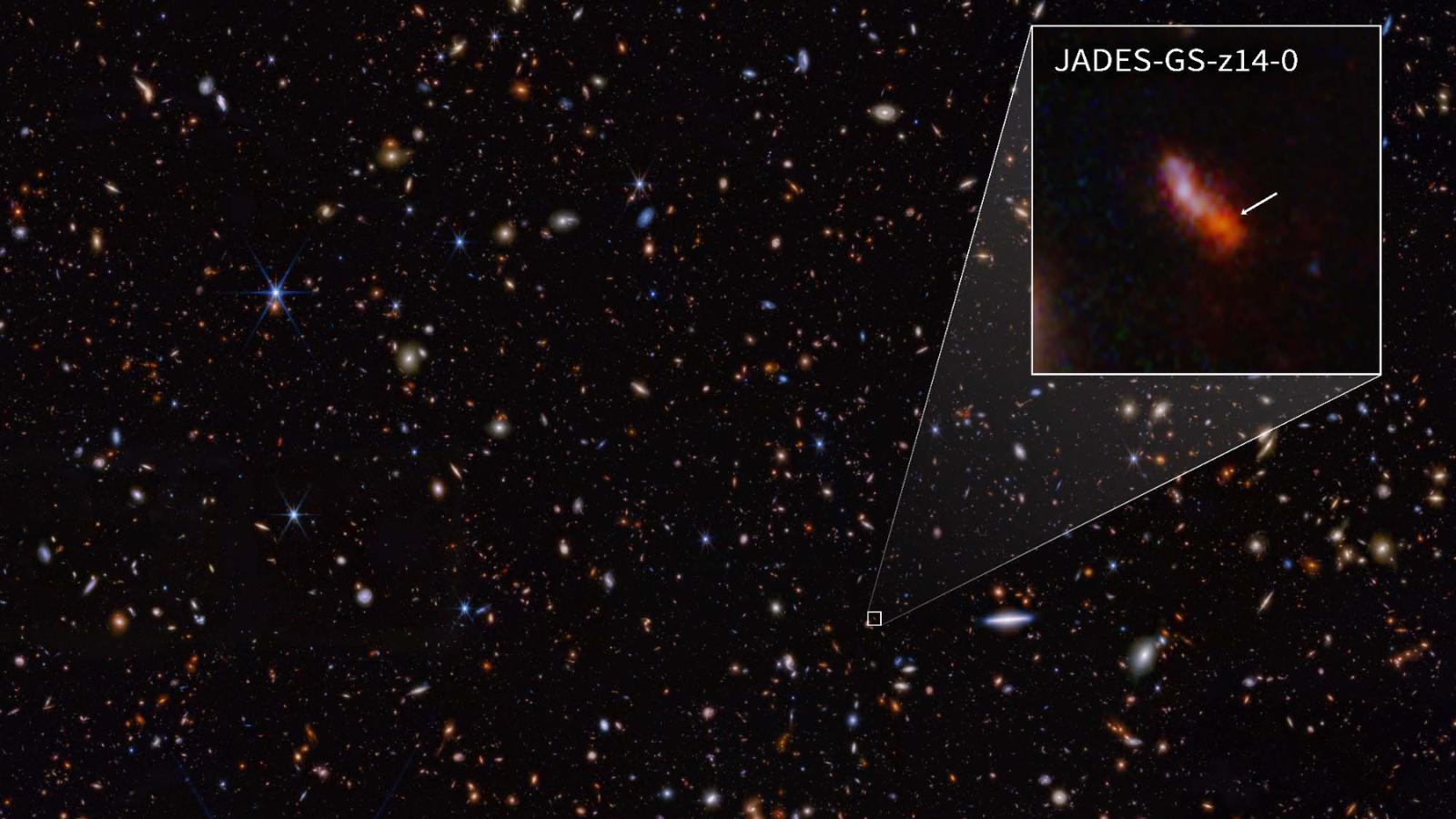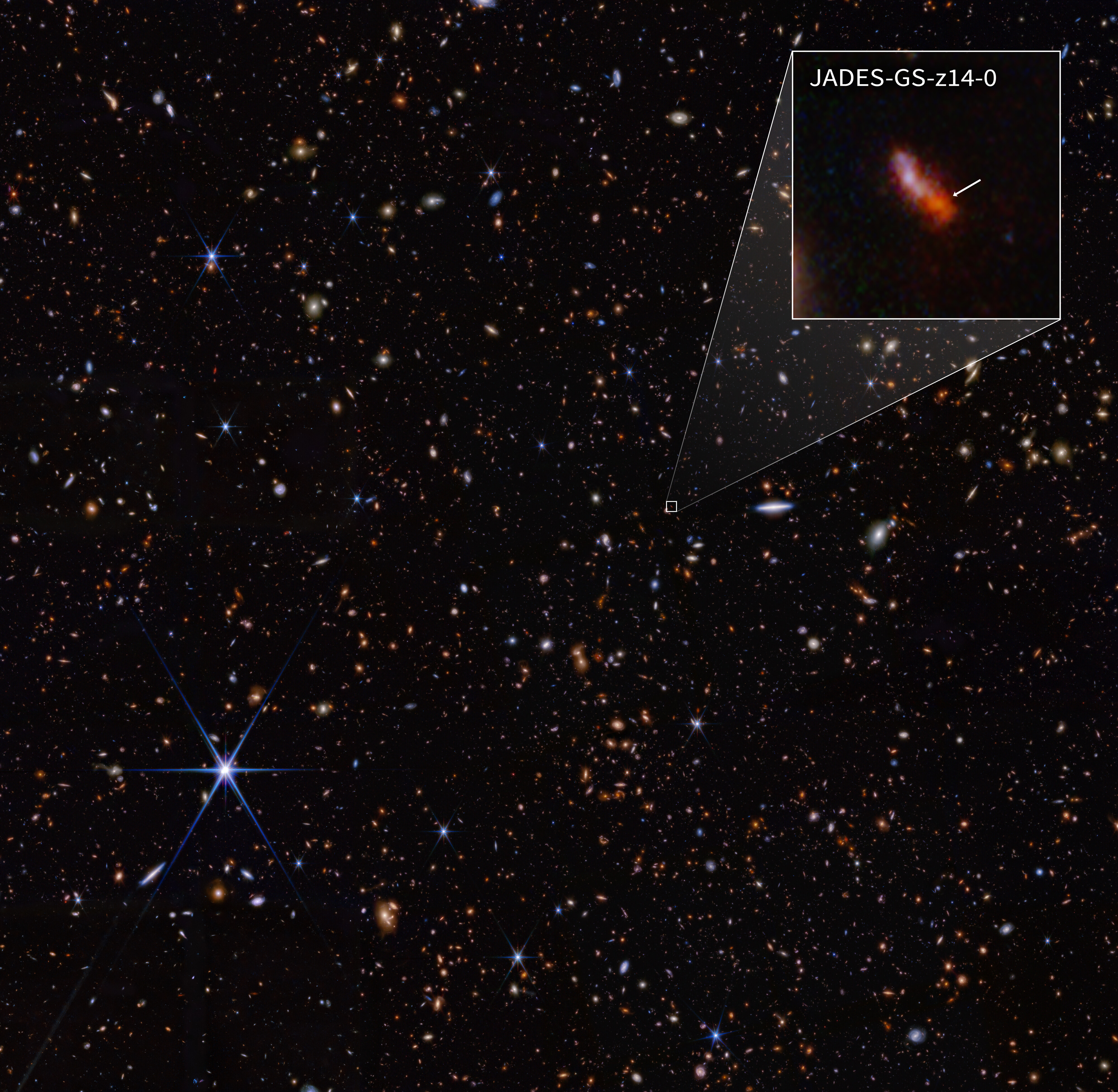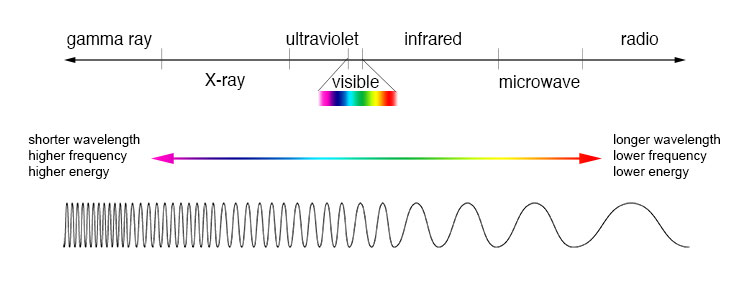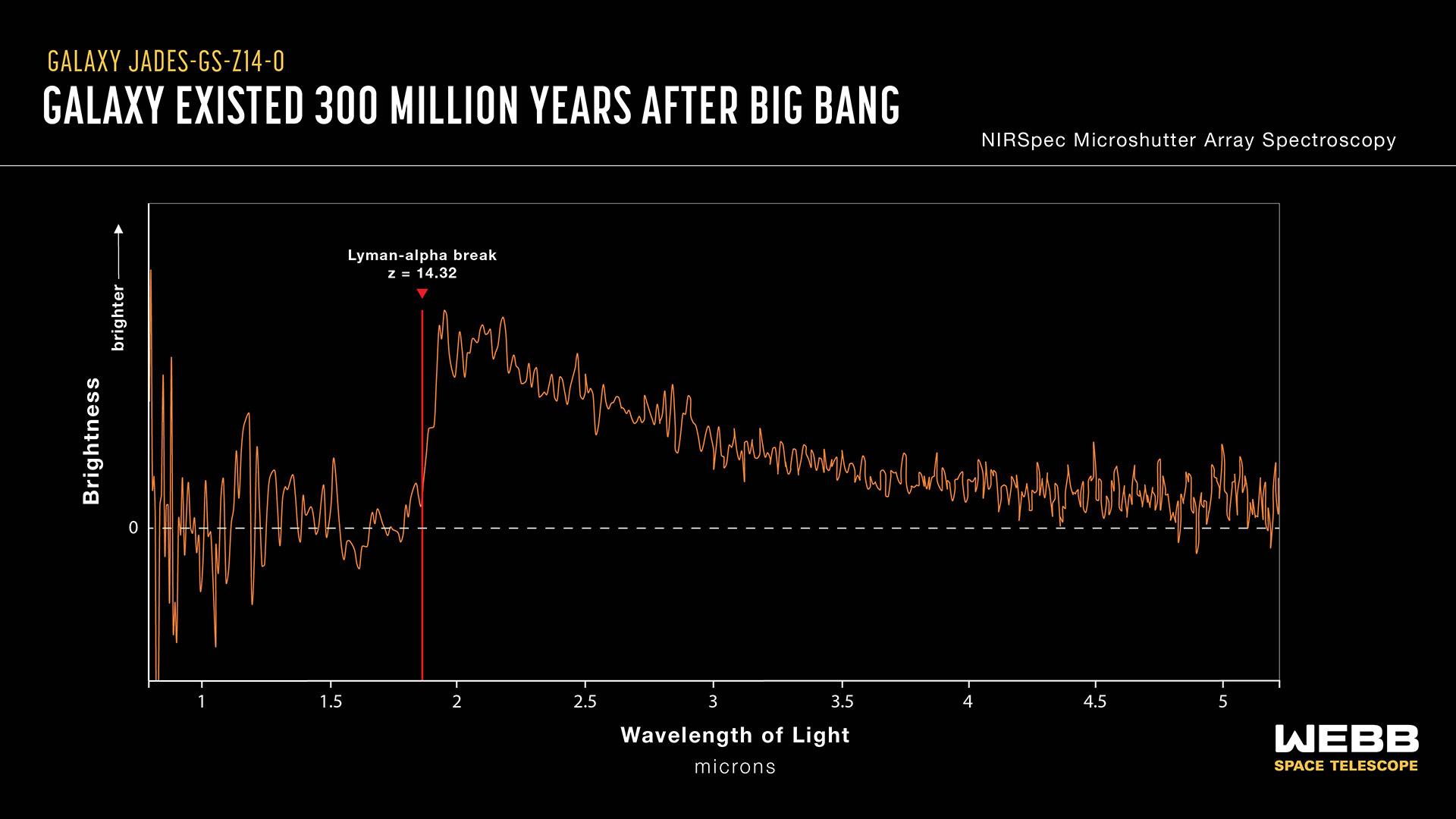James Webb Space Telescope spots the most distant galaxy ever seen (image)
The most distant JADES-GS-z14-0 is a massive and bright galactic record breaker that existed just 300 million years after the Big Bang.

The James Webb Space Telescope (JWST) has discovered not one but two of the earliest and most distant galaxies ever seen, continuing to break the records it previously set.
The furthest galaxy, JADES-GS-z14-0, is seen as it was around 300 million years after the Big Bang, existing at least 100 million years earlier than the previous record holder. That means that the light the JWST saw from this primordial galaxy has been traveling for 13.5 billion years on its way to reach us.
JADES-GS-z14-0 isn't alone, either. It was discovered along with another galaxy, JADES-GS-z14-1, that is almost as far away and takes second place in the ranking of the earliest galaxies ever seen by humanity.
Related: James Webb Space Telescope spots 3 of our universe's earliest galaxies
The announcement of the discoveries, made in Oct. 2023 and Jan. 2024, are the latest developments in the ongoing investigation of cosmic dawn that the $10 billion telescope has facilitated as part of the JWST Advanced Deep Extragalactic Survey (JADES) program. JADES aims to provide vital insights into the ways in which the stars, gas, and black holes were evolving in primordial galaxies when the 13.8 billion-year-old universe was very young.
"These galaxies join a small but growing population of galaxies from the first half billion years of cosmic history where we can really probe the stellar populations and the distinctive patterns of chemical elements within them," team member and Kavli Institute for Cosmology scientist Francesco D’Eugenio said in a statement.

JADES-GS-z14-0 isn't just remarkable for how distant it is from Earth and how early it existed in the cosmos, though. With a width of around 1,600 light-years across, this "cosmic dawn" galaxy is also remarkable for how big and bright it is.
Breaking space news, the latest updates on rocket launches, skywatching events and more!
"The size of the galaxy clearly proves that most of the light is being produced by large numbers of young stars, rather than material falling onto a supermassive black hole in the galaxy's center, which would [make it] appear much smaller, "JADES team leader Daniel Eisenstein from the Harvard & Smithsonian's Center for Astrophysics (CfA) said in a separate statement.
The extreme brightness of JADES-GS-z14-0 and the fact this luminosity is powered by young stars means this galaxy represents the most striking evidence for the rapid formation of large, massive galaxies in the early universe found thus far.
JADES team member and University of California-Santa Cruz researcher Ben Johnson added that JADES-GS-z14-0 shows that galaxy formation in the early universe was very rapid and intense.
"The JWST will allow us to find more of these galaxies, perhaps when the universe was even younger," he said. "It is a marvelous opportunity to study how galaxies get started."
The James Webb Space Telescope sees red to spot early galaxies
The JWST is adept at seeing early galaxies thanks to the high infrared sensitivity of its instruments, particularly its primary imager, the Near Infrared Camera (NIRCam).
Light leaves these cosmic dawn galaxies with a wide range of wavelengths similar to light from galaxies that are closer to the Milky Way. It is the journey of billions of years that transforms this light into low-energy and long-wavelength light in the near-infrared and infrared regions of the electromagnetic spectrum.
The very fabric of space is expanding, and as light passes through it, its wavelength is stretched along with it. This causes the light to "shift" down to the red end of the electromagnetic spectrum, hence the name for this phenomenon, "redshift."

Galaxies that are farther away have to cross more space (which is being stretched as it expands) before their light reaches us, and thus, that light experiences more redshift. Redshift, denoted as z, can, therefore, be used to measure the distance to celestial objects with a known spectrum. And because light takes a finite amount of time to travel, this distance can be used to calculate how long ago these galaxies existed as we see them.
JADES-GS-z14-0 has a redshift of z = 14.32, while the previous most distant galaxy, JADES-GS-z13-0, has a redshift of z = 13.2, which placed it as existing 400 million years after the Big Bang. Clearly, this newly found galaxy has absolutely smashed that record, with the JWST seeing back in time by another 100 million years or so.
"JADES-GS-z14-0 now becomes the archetype of this phenomenon," JADES collaboration team member Stefano Carniani of the Scuola Normale Superiore said. "It is stunning that the universe can make such a galaxy in only 300 million years."

JADES-GS-z14-0 delived some surprises
Not everything about JADES-GS-z14-0 was immediately clear to the JADES team and some elements could confuse our picture of the early cosmos.
When it was first spotted, the primordial galaxy was so close to a closer foreground galaxy that the team suspected they could be celestial neighbors. This idea was dispelled in October last year when the JADES crew spent five days performing a deep analysis of JADES-GS-z14-0 with NIRCam. The application of filters that are specifically tailored to identify early galaxies confirmed the extreme distance to JADES-GS-z14-0.
"We just couldn’t see any plausible way to explain this galaxy as being merely a neighbor of the more nearby galaxy," JADES team member and University of Arizona researcher Kevin Hainline said.
The galaxy also surprised its discoverers because its light is even redder than expected. That is because the light from JADES-GS-z14-0 is being "reddened" by dust within it that will become the building blocks of stars that will help this galaxy grow even larger.
Another surprise was the discovery of oxygen in JADES-GS-z14-0. Elements heavier than hydrogen and helium are forged by stars during their lifetimes and then distributed through galaxies when these stars explode. The observation of oxygen in JADES-GS-z14-0 could indicate that at least one generation of stars has already lived and died in this very early galaxy.
"All of these observations, together, tell us that JADES-GS-z14-0 is not like the types of galaxies that have been predicted by theoretical models and computer simulations to exist in the very early universe," JADES researcher Jake Helton of Steward Observatory and the University of Arizona said. "Given the observed brightness of the source, we can forecast how it might grow over cosmic time, and so far, we have not found any suitable analogs from the hundreds of other galaxies we’ve observed at high redshift in our survey."
Helton added that given the relatively small region of the sky that the JWST searched to find JADES-GS-z14-0, its discovery has profound implications for the predicted number of bright galaxies we see in the early universe.
"It is likely that astronomers will find many such luminous galaxies, possibly at even earlier times, over the next decade with the JWST," he concluded. "We're thrilled to see the extraordinary diversity of galaxies that existed at cosmic dawn!”
Join our Space Forums to keep talking space on the latest missions, night sky and more! And if you have a news tip, correction or comment, let us know at: community@space.com.

Robert Lea is a science journalist in the U.K. whose articles have been published in Physics World, New Scientist, Astronomy Magazine, All About Space, Newsweek and ZME Science. He also writes about science communication for Elsevier and the European Journal of Physics. Rob holds a bachelor of science degree in physics and astronomy from the U.K.’s Open University. Follow him on Twitter @sciencef1rst.
-
Helio Reply
That's a surprisingly early age for a "large" galaxy.Admin said:James Webb Space Telescope has spotted the two earliest and most distant galaxies ever seen. One, JADES-GS-z14-0, is a massive and bright galaxy that existed just 300 million years after the Big Bang.
James Webb Space Telescope spots the 2 earliest galaxies ever seen (image) : Read more
But is it "large" as quoted? The link to the "statement" claims it is large at 1,600 lyrs. in size (dia.). That is more "tiny" than large. I thought it was a typo so I sought the paper.
https://arxiv.org/pdf/2405.18485
It states it has a radius of about 260 pc, so ~1600 lyrs. in dia.
Are most other early galaxies tiny?
This is weird.
What am I missing? -
Unclear Engineer BBC's article puts the age of JADES-GS-z14-0 at 290 million years after the Big Bang. 10 million years is starting to be a significant issue with these early ages at large Z values. So, is the "about 300 million years" in this Space.com article a meaningful difference associated with the uncertainty, or what?Reply
Helio, a couple of thoughts: First, "large" seems to be a relative term related to expectations, rather than comparisons to locally observed galaxies. Second, it is not clear to me that the full extent of the galaxy is evident in the Webb observation. What was seen is said to be brighter than expected, but the story also says that the Webb telescope could see things 1/10 of that brightness. And, to make matters more complex, our line of sight to JADES-GS-z14-0 is going very close to a foreground galaxy. So, I am wondering if we can really detect the outer edges of JADES-GS-z14-0 to get its diameter with much accuracy.
I expect that Webb will find more of these, so there should be some confirming or confusing data coming in the future. If Webb really can see things at 1/10 the brightness, could it see twin of JADES-GS-z14-0 at an even earlier age. It will be interesting to see how far back we can see galaxies. And, if they are as "old" as we can see, "We're going to need a bigger telescope!" -
Classical Motion With every instrument we build and use, we can't wait for something larger. Let's develop a long term plan. Let's start dropping optical "pixels" on the far side of the moon. A "pixel" would be an optical unit dropped from orbit. Self leveling, self inflating, self aiming and self powered. Networked with the other pixels. Radio detectors can be added to this also. The whole spectrum. Using the far side would be intermittent, but it's the only dark and quiet place left.Reply
Like putting thousands of cube sats in Earth's orbit, start dropping thousands of pixels on the far side. Grow an array. A very large array. It might take a few decades to assemble.
Make the far side the quiet and soft side. An out of bounds zone. A Solar Park. A scanning eye and a scanning ear. Passive. A second generation could be made active for long range or high speed communications.
What we really need is a new method for collecting light. Make telescopes on an assembly line. Stamp them out. Something inflatable, or easily foldable, self shaping and self distorting for beaming. Surface shaping control. Durable, self repairing and above all, cheap.
Is that too much? We could put pixels in all the planetary Lagrange points. Let's go big now and get it over with.
After all, the only thing we'll ever do is look and listen. No matter what we see or what we hear. -
Helio Reply
IMO, these vast distances become more problematic since certain paramaters must be assumed to get to these times. These are used in Ned Wright's calculator online. Rob might be able to address this better.Unclear Engineer said:BBC's article puts the age of JADES-GS-z14-0 at 290 million years after the Big Bang. 10 million years is starting to be a significant issue with these early ages at large Z values. So, is the "about 300 million years" in this Space.com article a meaningful difference associated with the uncertainty, or what?
Yes, this is one reason I asked if "tiny" galaxies were the norm during this time frame. BBT predicts the first galaxies would appear immature, and would likely be smaller than today. But 1600 lyrs. is a surprise.Unclear Engineer said:
Helio, a couple of thoughts: First, "large" seems to be a relative term related to expectations, rather than comparisons to locally observed galaxies. Second, it is not clear to me that the full extent of the galaxy is evident in the Webb observation. What was seen is said to be brighter than expected, but the story also says that the Webb telescope could see things 1/10 of that brightness. And, to make matters more complex, our line of sight to JADES-GS-z14-0 is going very close to a foreground galaxy. So, I am wondering if we can really detect the outer edges of JADES-GS-z14-0 to get its diameter with much accuracy.
You may be right that this small size may be only for the brighter portion of the galaxy, but this should have been stated, or perhaps it was and I just missed it
Yes, and I recommend a bigger telescope. ;)Unclear Engineer said:I expect that Webb will find more of these, so there should be some confirming or confusing data coming in the future. If Webb really can see things at 1/10 the brightness, could it see twin of JADES-GS-z14-0 at an even earlier age. It will be interesting to see how far back we can see galaxies. And, if they are as "old" as we can see, "We're going to need a bigger telescope!"
